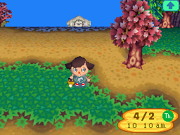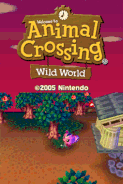Template:Feature Animal Crossing: Wild World, known in Japan as Animal Forest: Come on Over (おいでよどうぶつの森 Oideyo Dōbutsu no Mori?) is a life simulation game for the Nintendo DS, set in a town where the player is a person who lives among animals. It is a follow-up to the 2002 hit Animal Crossing for the Nintendo GameCube and the Japan-only Animal Forest, Animal Forest+, and Animal Forest e+. During development, the working title was 'Animal Crossing DS'.
The important features of the first Animal Crossing series game return in this one, but with improvements and many changes. Activities in town include buying and selling items, fishing, and several others, especially becoming friends with the villagers. The game occurs in real time, with the real calendar, and time progresses even when the game is turned off.
Online play
Wild World is the second Nintendo title that uses the Nintendo Wi-Fi Connection, the first being Mario Kart DS. This lets players use wireless access points to connect to the Internet and visit other players' towns. As of May 20th, 2014, Nintendo Wi-Fi Connection on the Nintendo DS and Nintendo Wii has been discontinued. This terminated Animal Crossing: Wild World's Wi-Fi capability. The local multiplayer will still work because it does not use Wi-Fi. However, some homebrew developers have created their own custom servers allowing Wild World to be played online again.
Release
Wild World was released in Japan on November 23rd, 2005. It was released in North America on December 5th, 2005, in time for Christmas. Players in Europe had to wait until March 31st, 2006 for the European release. It was rereleased in Japan with copies of Doubutsu No Mori.
Gameplay
Following the release of the popular GameCube original, the player starts out as a human in a town with no money. The player mortgages a small house from the local shopkeeper, the Tanuki (or raccoon in the English version) Tom Nook. Paying off a loan results in a larger house. All players live together in one house.

The interface of Wild World, with the date and hour in the bottom-right corner
Many players will want a bigger house, because decorating their house in their way, with furniture and other items, is one of the main features of the game. The player can collect fruit, fish, insects, paintings, fossils, furniture, and other items. There are over 550 different pieces of furniture. Once the player has some furniture, taking it to their house is easy; the furniture becomes a leaf that fits in their pocket. They can also customize themselves by buying clothes, accessories, hats, or drawing patterns.
Outside the house, the player can befriend the animal neighbors. The animals are much more interactive in this game than they were in the GameCube game. The animals can still ask the player to do errands for them, but there is no longer an explicit menu item to request them, and they no longer require to find a missing item from a long chain of animals. Animals can also give the player their picture of themselves, with a unique quote on the back that is the players to keep, even after they move away.
The player can also customize their town by planting trees and growing flowers. At the museum, the player can donate certain items to the collections. At the tailor's, the player can buy clothes or draw their own patterns. This way, the player can customize their town.
And if animals are not enough, the player can invite up to three human friends to their town using the Nintendo Wi-Fi connection or DS to DS.
New additions
- Using Nintendo's Wi-fi connection, visit friends online, and the DS to DS connection for friends nearby.
- New tools (Slingshot, Golden Watering Can)
- New holidays (Yay Day, La-Di day, etc.)
- More customizable than the original, with the ability to change hat, facial accessories and hair style, and umbrella.
- Design your own patterns and use them in more places than you could in the GameCube version. Use them as wallpaper, carpets, clothes, hats-which differ by gender, and even place designs on the floor.
- New characters, like Celeste, the observatory owl, Brewster the barman, and Harriet the salon hair stylist.
- You can see the sky. Draw constellations, and they will appear at night.
- The museum holds larger collections, and now also has an observatory and a café.
- Animal villagers sometimes give you their picture, so you can remember them even after they move out of town.
- Animal villagers are much more interactive. They will chase you to talk to you, challenge you to fishing or bug-catching matches, come to your house for a chat, and even tend to their own gardens, give you picture of themselves, and have you buy them furniture.
- At 8:00 PM each Saturday, go to the cafe to hear K.K. Slider play. Also some new songs were added, like Marine Song 2001, Steep Hill, and Pondering.
- The player can use either the control pad or the touch screen to control their character. The stylus and the touch screen make it much easier to move, manage items and type letters.
- If the player puts a letter in a bottle, it might wash up on a random person's shore, or your own.
- There are 16 new fish, as well as 16 new bugs. For more information see Insects (Wild World).
- New villager types(Monkey)
- You can now hybrid flowers.
- 72 villagers are introduced, such as Drake
- Wi-Fi was introduced.
Changes
- Blathers can now identify fossils himself.
- Crazy Redd won’t let you come in his shop until you are a member and know a “password” which is given away by a random villager.
- Tom Nook no longer sells clothes and umbrellas. The Able Sisters now sell clothes and umbrellas .
- Some characters from the Animal Crossing GameCube and Animal Forest e+ have been erased, replaced or absent.
- Some items and collectibles do not appear. (the collectible NES Games do not appear)
- Some buildings are gone. The police station and post office building have been removed from each town, but the town gate and town hall replaces them. The wishing well is gone and town dump is gone, but the recycle bin at the town hall replaces it. There is no train station.
- Don Resetti does not appear. Don Resetti re-appears in City Folk.
- The acre system is gone. The world now scrolls continuously, without sudden camera changes at acre boundaries. The world appears cylindrical; objects in the distance curve away so that you can see the sky instead of just having a top-down view.
- The old password system for shipping items between towns is gone. You can now carry items through the Wi-Fi Connection. Also, the password to get items that you want at the Tom Nook stores, are removed, so the player would have to get everything from scratch.
- Tom Nook sells only one house, not four houses, but up to four human players can live in the same house. In City Folk Nook sells 4 houses again.
- The journal feature, where you could write a public or private journal each month, is gone.
- Container furniture such as wardrobes and dressers work differently. Each player has a storage area that holds 96 items, and they can use any dresser to access it. This feature replaces the basements of the GameCube game. (In the GameCube game, dressers each held 3 items.)
- Certain holidays from the GameCube version have been taken out, such as Animal Crossing versions of Christmas and Halloween. These holidays return in City Folk.
- You can only go into other villagers' houses when they are inside them and awake.
- The entire soundtrack is changed; the title screen, all 24 hour themes, all four Nook stores, the tailor, and the town hall (even though not in the GameCube version, it still is similar to the post office) plus the gate (same instance as the town hall). This soundtrack is kept for Animal Crossing: City Folk but the Resetti music use the GameCube soundtrack.
- Animalese is altered to bear a closer resemblance to the version heard in the Japanese versions of Animal Crossing, and has stayed this way since.
- The Classic Hutch is no longer part of the Classic Series. It is replaced by the Classic Buffet.
- Gracie will no longer ask you to wash her car to get a shirt. She gives you one by giving you a Fashionista Badge, you can also get another one by talking to her and offer her 5000 or more Bells.
- The lottery is no longer in the games. It is replaced by Spotlight Items.
- To get the Golden Axe, you need to do a trading event, making this harder and more annoying.
Problems
On January 26, 2006, an accident occurred relating to the Wi-Fi features. A few weeks prior,Nintendo sent out a free Mario Coin item from Satoru Iwata to all who connected to Wi-Fi while it was available. On the same day, a failed attempt to send a second exclusive item sent a blank letter to all who connected to Nintendo Wi-Fi before 5:00 PM. This letter contained the "glitched red tulip" item. This item could be planted in cement as a tree or, if put into the player's house, would create an invisible, irremovable wall. The item could be disposed of by planting it in the ground or selling it. On February 13, 2006, Nintendo sent out a letter containing 10,000 Bells and an amusing town bulletin board notice to apologize for the mistake.
Trivia
- In the game, The Able Sisters is always to the east of Tom Nook's Store, but on the cover they are separated.
| Animal Crossing | ||
|---|---|---|
 | ||
| See also | ||
| Games | ||

